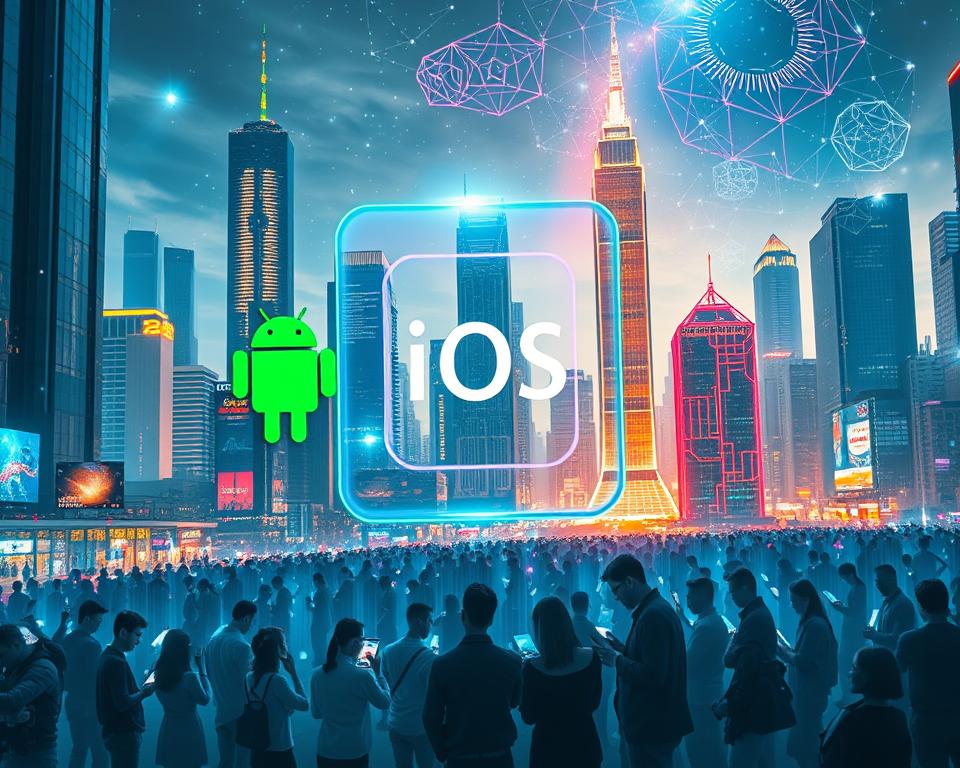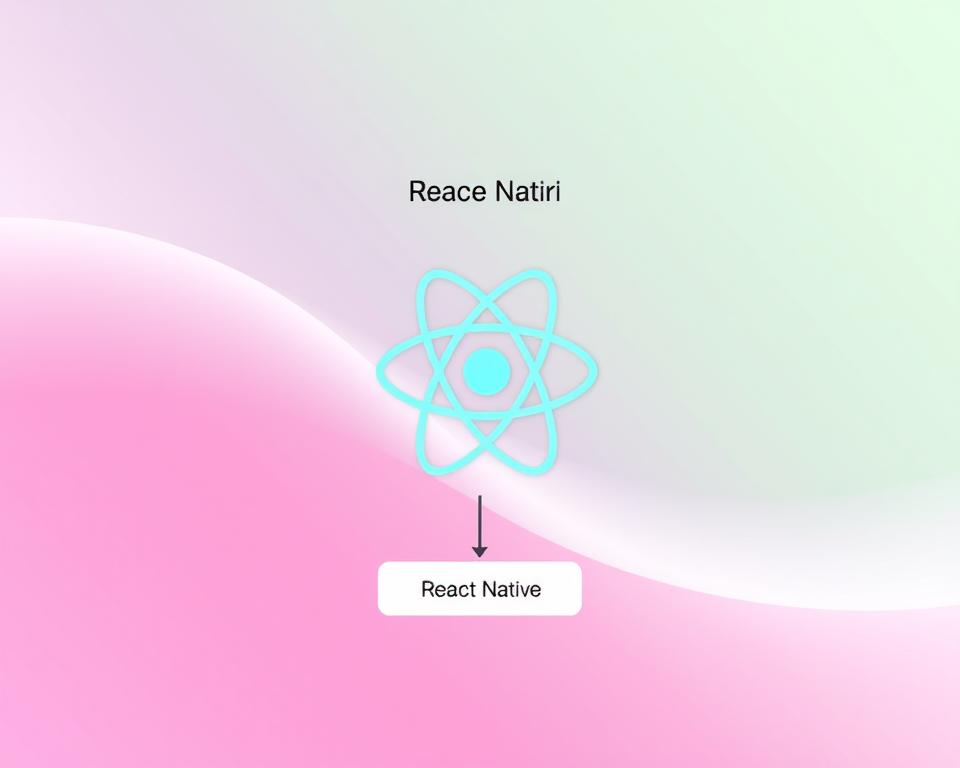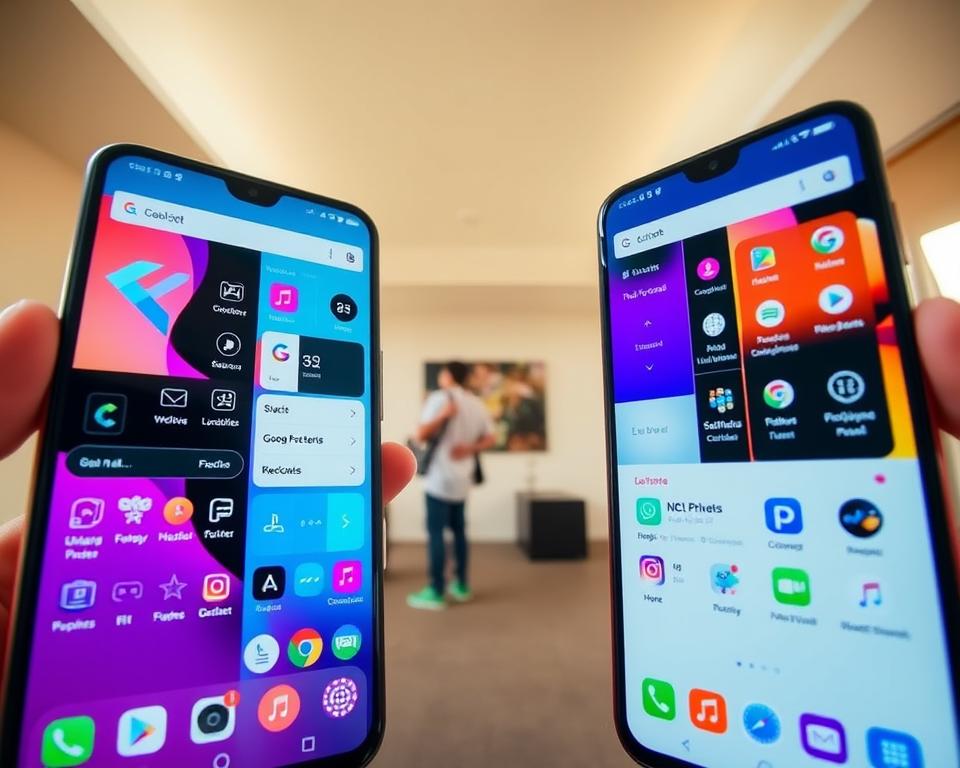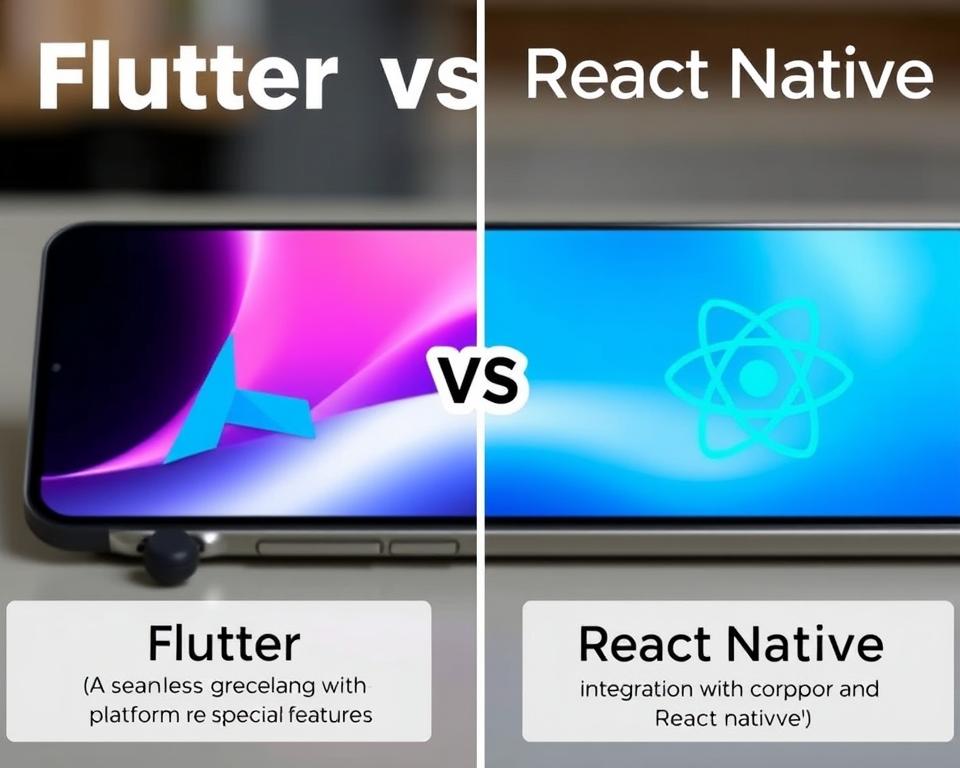Cross-platform mobile development is key in today’s tech world. Frameworks like Flutter and React Native let developers make apps for many platforms with one code. This makes app creation easier and faster.
Deciding between Flutter and React Native can be tough. They have different ways of working and benefits. This article will help you understand the differences to choose the right one for your needs.
As more people want apps that work on many devices, knowing what each framework does well is important. This knowledge helps in creating successful cross-platform mobile development projects.
Table of Contents
Key Takeaways
- Overview of Flutter and React Native frameworks
- Comparison of their architectures and performance
- Discussion on the ease of development and learning curve
- Analysis of their suitability for different project requirements
- Insights into the community support and resources available
The Rise of Cross-Platform Mobile Development
Cross-platform mobile development has changed the app world. Now, businesses want apps that work well on many platforms. This means they need quick, affordable ways to make these apps.
The Evolution of Mobile App Development
Mobile app making has evolved a lot. At first, apps were made for just iOS and Android. This meant writing code for each platform, which took a lot of time and money.
Then, cross-platform tools came along. These tools let developers write code once. This code then works on many platforms.
Benefits of Cross-Platform Development
Cross-platform development has many benefits. Here are a few:
- Reduced Development Time: Writing code once saves a lot of time.
- Cost-Effectiveness: It’s cheaper to keep one codebase than many.
- Faster Time-to-Market: Apps can be released on many platforms at once.
As Forbes points out, “Cross-platform tools have changed the game for businesses wanting fast app deployment.”
“Cross-platform development is not just a trend; it’s becoming the new standard for mobile app development.”
Current Market Leaders
Flutter and React Native are leading in cross-platform development. Both are popular and offer unique benefits.
| Framework | Key Features | Market Presence |
|---|---|---|
| Flutter | Fast development, expressive UI, native performance | Strongly growing, backed by Google |
| React Native | JavaScript-based, large community, easy integration with web technologies | Mature, backed by Facebook |
Knowing the good and bad of these frameworks is key. It helps businesses and developers make the best choice for their needs.
What is Flutter?
Flutter is an open-source UI software development kit made by Google. It changes how developers make apps for mobile, web, and desktop. With its widgets, Flutter lets developers make beautiful apps for different platforms from one codebase.
Google’s UI Toolkit
Flutter is Google’s UI toolkit for making apps. It has a wide range of widgets that follow Material Design for Android and Cupertino style for iOS. This ensures apps look and feel native on different platforms. Flutter’s widget-based architecture makes it easy to customize and create complex UIs.
Dart Programming Language
Flutter apps use the Dart programming language, also from Google. Dart is easy for developers to learn, especially those who know Java or C#. It compiles apps quickly for development and runs fast in production. This makes Dart great for building Flutter apps.
Flutter’s Architecture
Flutter’s architecture is layered. The framework layer has pre-built widgets, and the engine layer handles rendering and input. This setup makes Flutter’s UI components render smoothly and efficiently. This is why Flutter apps run so well.
Key Features and Advantages
Flutter has many key features and advantages:
- Fast development with hot reload
- Rich set of customizable widgets
- High-performance rendering
- Single codebase for multiple platforms
- Strongly typed, object-oriented Dart language
| Feature | Description | Benefit |
|---|---|---|
| Hot Reload | Instantly see changes without recompiling | Faster development cycle |
| Rich Widgets | Pre-built UI components | Consistent and native-like UI |
| AOT Compilation | Compile to native code for release | High performance in production |
As Flutter continues to evolve, it’s a top choice for developers and businesses. They can make high-quality apps for many platforms with just one codebase.
“Flutter has been a game-changer for our development team, allowing us to deliver a seamless user experience across both Android and iOS platforms.”
What is React Native?
Facebook created React Native, an open-source framework. It lets developers make native mobile apps with JavaScript and React. It’s popular because it allows apps for both iOS and Android from one codebase.
Facebook’s JavaScript Framework
React Native uses React, a JavaScript library for UIs. It lets developers make reusable UI components. This makes apps faster to build and look the same on all devices.
Key Benefits of Using React Native:
- Cross-platform compatibility
- Reusable components
- Large community support
- Fast development and hot reloading
React and JavaScript Foundation
React Native is based on React and JavaScript. It uses JSX to define UI components. This makes UI code easy to write and maintain.
React Native’s Architecture
React Native’s design helps create native mobile apps. It uses a bridge to connect JavaScript and native modules. This lets developers use native APIs and components smoothly.
Key Features and Advantages
React Native has many key features. These include:
| Feature | Description | Advantage |
|---|---|---|
| Hot Reloading | Allows developers to reload the app without losing the current state. | Faster development cycle |
| Reusable Components | Enables the reuse of UI components across different platforms. | Reduced development time and cost |
| Native Performance | Uses native components to achieve performance close to native apps. | Better user experience |
React Native’s features make it great for building high-quality, cross-platform mobile apps.
Flutter vs React Native: Which One Should You Use?
In the world of cross-platform mobile development, Flutter and React Native are top choices. But which one is best for you? Your decision depends on your team’s skills, the project’s needs, and your business goals.
Key Differences at a Glance
First, let’s look at the main differences between Flutter and React Native. Flutter is an open-source UI kit by Google, known for quick development and a wide range of widgets. React Native, on the other hand, is from Facebook. It lets developers make native apps with React and JavaScript.
- Flutter uses Dart, while React Native uses JavaScript and React.
- Flutter has more built-in UI components. React Native might need extra libraries for some UI elements.
- Flutter focuses on widgets, while React Native uses a bridge to native components.
Decision Factors for Developers
Developers often choose based on their skills and what they’re willing to learn. Dart, Flutter’s language, is easy for those familiar with object-oriented programming. React Native, using JavaScript and React, is easier for web developers to get into.
Other important factors include:
- The tools and IDE support available.
- The hot reload feature, which boosts productivity in both frameworks.
- The quality and variety of libraries and packages for each framework.
Decision Factors for Businesses
Businesses should think about development costs, time-to-market, and app maintenance. Flutter offers quick development with its wide widget library and single codebase deployment. React Native is more affordable for businesses already using React.
| Factor | Flutter | React Native |
|---|---|---|
| Development Speed | Fast, thanks to its widget library | Fast, especially for React developers |
| Cost | Potentially lower due to single codebase | Can be cost-effective, especially with existing React expertise |
The choice between Flutter and React Native depends on your specific needs. Whether you’re a developer or a business, consider your goals, skills, and resources.
Performance Comparison
Mobile app users want apps that are fast and responsive. It’s important to know how Flutter and React Native compare in this area.
Rendering Mechanisms
Flutter uses Skia, its own rendering engine. This engine makes sure apps look good and run smoothly on all platforms. It handles drawing UI components and animations.
React Native, on the other hand, uses native components for rendering. This gives apps a more natural feel. But, it can lead to performance differences on different devices.
Application Size and Load Time
App size and how fast they load are key to a good user experience. Flutter apps are often bigger because of the Flutter engine. But, they can be developed faster and might be smaller overall.
React Native apps are usually smaller. But, they might need more native modules, which can make development harder and increase size.
| Framework | Average App Size | Load Time |
|---|---|---|
| Flutter | 15-20 MB | Fast |
| React Native | 10-15 MB | Variable |
CPU and Memory Usage
Both frameworks have their good and bad points when it comes to CPU and memory. Flutter’s compiled code and efficient engine help it perform well.
React Native can also perform well, but it might vary more. This is because it uses JavaScript and needs to bridge to native code.
Benchmark Results
Many benchmarks show Flutter beats React Native in rendering and tasks that need lots of computing. But, React Native is good enough for many apps. It’s fast to develop and works well with web technologies.
User Interface and Experience
The user interface (UI) and user experience (UX) are key in mobile app development. They greatly affect how users engage and stay with an app. Knowing how Flutter and React Native handle UI and UX is vital for developers and businesses.
Flutter’s Widget System
Flutter’s UI is built with its widget system. It has a wide range of pre-designed widgets that follow Material Design and Cupertino guidelines. This makes it easy for developers to create beautiful and consistent UIs on various platforms.
Key benefits of Flutter’s widget system include:
- Highly customizable widgets
- Consistent look and feel across platforms
- Ease of use for developers familiar with widget-based architectures
React Native’s Component Approach
React Native uses a component-based approach for UIs. It uses React’s component model to create reusable and modular UI components.
Advantages of React Native’s component approach:
- Reusability of code across platforms
- Familiarity for developers with React experience
- Flexibility in customizing UI components
UI Consistency Across Platforms
Both Flutter and React Native aim for consistent UIs across platforms. But they go about it differently:
| Framework | UI Consistency Approach |
|---|---|
| Flutter | Uses its rendering engine to draw widgets, ensuring consistency |
| React Native | Maps JavaScript components to native views, achieving near-native look and feel |
Animation and Custom UI Capabilities
Animation and custom UI capabilities are key for engaging user experiences. Both frameworks support these features well:
Flutter’s animation capabilities:
- Built-in animation support with the
AnimationandAnimationControllerclasses - High-performance rendering for smooth animations
React Native’s animation capabilities:
- Uses the Animated API for creating animations
- Layscript library for more complex animations
A Flutter developer noted, “Flutter’s animation system is highly flexible. It allows for complex, high-performance animations that are crucial for a great user experience.”
“The ability to create custom, high-quality animations is a key differentiator for mobile apps. Both Flutter and React Native provide the necessary tools to achieve this.”
In conclusion, both Flutter and React Native are strong options for creating engaging UIs and UXs. The choice between them depends on the project’s specific needs, including customization, performance, and the team’s expertise.
Development Experience and Productivity
Flutter and React Native have different ways of working. Each has its own strengths and weaknesses. It’s important for developers and businesses to know these differences when choosing for their mobile app projects.
Learning Curve and Language Accessibility
Flutter uses Dart, a language designed to be easy to learn. It’s great for developers who know object-oriented programming. React Native, on the other hand, uses JavaScript and React. This makes it easier for more developers to use, thanks to JavaScript’s wide use.
“React Native is perfect for web developers moving to mobile apps,” says a developer at a leading tech firm.
Development Tools and IDE Support
Both frameworks have strong tools and IDE support. Flutter works well with Android Studio and Visual Studio Code. React Native also supports Visual Studio Code and IntelliJ IDEA, with lots of plugins for React and JavaScript.
- Flutter: Android Studio, Visual Studio Code
- React Native: Visual Studio Code, IntelliJ IDEA
Hot Reload and Developer Workflow
Hot Reload is a key feature for both frameworks. It makes developers more productive. Flutter’s Hot Reload lets developers see UI changes without recompiling. React Native’s Fast Refresh does the same.
“Hot Reloading in React Native has been a game-changer for our development workflow, allowing us to iterate quickly and efficiently,” notes a senior developer at a prominent tech company.
Testing and Debugging Capabilities
Both Flutter and React Native have great testing and debugging tools. Flutter has widget tests, integration tests, and unit tests. React Native supports Jest for unit testing and Detox for end-to-end testing.
| Feature | Flutter | React Native |
|---|---|---|
| Testing Frameworks | Flutter Test, Integration Tests | Jest, Detox |
| Debugging Tools | Flutter DevTools, Dart Observatory | Chrome DevTools, React DevTools |
In conclusion, both Flutter and React Native offer strong development experiences and productivity features. The choice between them depends on the team’s needs and the project’s requirements.
Community and Ecosystem Support
Community and ecosystem support are key for frameworks like Flutter and React Native. A strong ecosystem makes development better and the final product higher quality.
Library and Package Availability
Flutter and React Native both have big libraries and packages. Flutter’s Pub.dev has many packages for UI and complex tasks. React Native’s npm has a huge array of modules for projects.
Community Size and Activity
The size and activity of a framework’s community show its health. Flutter, backed by Google, has grown fast with active GitHub and Stack Overflow users. React Native, supported by Facebook, also has a big, active community, making its ecosystem rich.
| Framework | Community Size | GitHub Stars | Stack Overflow Questions |
|---|---|---|---|
| Flutter | Large | Over 150k | Over 100k |
| React Native | Very Large | Over 100k | Over 200k |
Documentation Quality
Good documentation is key for developers. Flutter’s documentation is top-notch, helping new developers start easily. React Native’s documentation is also extensive but some find it less organized than Flutter’s.
Corporate Backing and Long-term Viability
Corporate backing is vital for a framework’s future. Flutter is supported by Google, ensuring ongoing development. React Native, backed by Facebook, also has strong support, helping its stability and future.
In conclusion, Flutter and React Native both have strong community and ecosystem support. Each has its own strengths and weaknesses. Knowing these is important for developers and businesses choosing a framework.
Native Feature Integration
Adding native features to mobile apps can make them better and more fun to use. Both Flutter and React Native help developers get to device hardware and use native modules. They also let developers write code just for certain platforms and add third-party services.
Accessing Device Hardware
Many apps need to use the camera, GPS, or Bluetooth. Flutter lets developers talk to native code through platform channels. For example, the camera package makes it easy to use the camera.
React Native works in a similar way. It connects JavaScript to native code, so apps can use device hardware. The react-native-camera package makes adding camera features simple.
Native Module Integration
Apps that need to talk directly to the device’s OS use native modules. Flutter uses Dart’s foreign function interface for this. React Native uses Java or Swift/Objective-C to do the same.
Platform-Specific Code Implementation
Sometimes, apps need to act differently on different platforms. Flutter lets developers write code just for certain platforms using platform channels. React Native does the same with native modules.
Third-party Service Integration
Adding services like payment gateways or social media is common. Both frameworks have tools for this. For example, Flutter has stripe_payment for payments, and React Native has react-native-stripe.
| Feature | Flutter | React Native |
|---|---|---|
| Accessing Device Hardware | Platform Channels | Native Modules |
| Native Module Integration | Dart’s Foreign Function Interface | Native Modules in Java/Swift |
| Platform-Specific Code | Platform Channels | Native Modules |
| Third-party Services | Packages (e.g., stripe_payment) | Libraries (e.g., react-native-stripe) |
Business Considerations
Choosing between Flutter and React Native goes beyond tech to business impact. Businesses must look at several key factors. These factors affect their profits and project success.
Development Cost and Time-to-Market
Development cost and how fast you can get to market are crucial. Flutter’s single codebase can make development faster and cheaper. React Native also speeds up development, but project complexity can slow it down.
Development Cost Comparison:
| Aspect | Flutter | React Native |
|---|---|---|
| Codebase | Single codebase for multiple platforms | Shared codebase with some platform-specific code |
| Development Speed | Faster development with Flutter’s widgets | Fast development with reusable React components |
Talent Availability and Team Structure
Having skilled developers and the right team structure is key. Flutter needs Dart knowledge, while React Native requires JavaScript and React skills. The choice depends on your team’s expertise.
Maintenance and Update Costs
Both frameworks make maintenance easier because they work across platforms. But, update costs, especially for React Native’s native modules, can differ.
Return on Investment Analysis
When looking at ROI, consider all costs and app revenue. Flutter and React Native can offer good ROI if chosen right for your project.
In conclusion, businesses must carefully consider these factors. This helps make a decision that fits their goals and budget.
Real-World Use Cases
Real-world examples show when to pick Flutter or React Native for mobile apps. They help developers and businesses choose the right tech for their projects.
When to Choose Flutter
Flutter is great for apps needing lots of customization and a smooth user experience on both Android and iOS.
Ideal Project Types
Flutter works well for complex, visually rich apps, like:
- Gaming apps
- Financial apps needing top security
- Apps with intricate UI/UX designs
Success Stories and Case Studies
Google, Alibaba, and BMW have used Flutter for their mobile apps with success.
When to Choose React Native
React Native is good for projects using web tech and needing to share code across platforms.
Ideal Project Types
React Native fits well for:
- Cross-platform apps with a shared codebase
- Apps needing fast prototyping and development
- Projects built on existing React web apps
Success Stories and Case Studies
Facebook, Instagram, and Walmart have used React Native for their apps. They benefit from code sharing between web and mobile.
Future Outlook and Trends
It’s important for developers and businesses to know what’s next for Flutter and React Native. These frameworks are always getting better. We need to look at their plans and what’s happening in the industry.
Flutter’s Roadmap and Web/Desktop Support
Flutter is growing beyond just mobile apps. With Flutter 2, Google added support for web and desktop apps. This makes Flutter more appealing to developers, as they can work on many platforms with one codebase.
Key Highlights:
- Enhanced web support with improved performance and rendering
- Desktop support for Windows, macOS, and Linux
- Continued improvements in Flutter’s UI toolkit
React Native’s New Architecture
React Native is changing with a new architecture. It aims to boost performance, make code easier, and work better with the latest React updates.
Key Features:
- Improved performance through a more efficient bridge
- Better compatibility with React features and future updates
- Simplified module integration and native code interaction
Industry Trends in Cross-Platform Development
The need for tools that work across platforms is growing. This is because developers want to work faster and save money. The trends include:
- Increased adoption of cross-platform frameworks
- Growing importance of web and desktop support
- Enhanced focus on performance and user experience
Emerging Competitors
New players are entering the cross-platform scene, even though Flutter and React Native are leaders. Frameworks like Xamarin, Kotlin Multiplatform, and others are becoming popular. They offer different options for developers.
Notable Emerging Competitors:
- Kotlin Multiplatform
- Xamarin
- Ionic with Capacitor
Conclusion
Choosing between Flutter and React Native for cross-platform mobile development depends on several factors. These include project requirements, team expertise, and long-term goals. Both frameworks have their strengths and weaknesses, as discussed throughout this comparison.
Flutter offers a robust UI toolkit with a rich set of widgets. It’s ideal for applications needing complex, custom interfaces. Its architecture ensures high performance, and Google’s backing provides stability and future-proofing.
React Native, on the other hand, leverages the power of JavaScript and React. It’s a great choice for developers already familiar with these technologies. Its ability to share code between platforms and access native modules is a significant advantage.
In conclusion, the decision between Flutter and React Native should be based on a thorough evaluation. You need to consider your project’s specific needs and your team’s capabilities. By understanding the key differences and advantages of each framework, you can make an informed decision. This decision will align with your business objectives and technical requirements, leading to a successful Flutter vs React Native summary for your project.



















